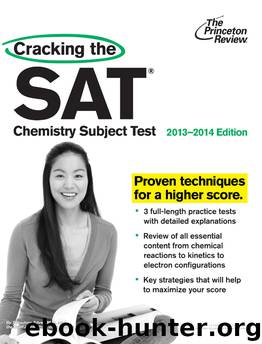Cracking the Sat Chemistry Subject Test 2013-2014 Edition by The Princeton Review

Author:The Princeton Review [Review, The Princeton]
Language: eng
Format: epub
Tags: Itzy, Kickass.to
ISBN: 9780307945761
Amazon: B00C4BA5US
Publisher: Princeton Review
Published: 2013-04-16T04:00:00+00:00
Cu2+(aq) + Zn(s) → Cu(s) + Zn2+(aq)
Here are the half-reactions and E0 values.
Oxidation: Zn(s) → Zn2+(aq) + 2e−; E0ox = 0.76 V
Reduction: Cu2+ (aq) + 2e− → Cu(s); E0red = 0.34 V
For the above reaction, E0cell is 0.76 V + 0.34 V = 1.10 V. Since E0cell > 0, this redox reaction is spontaneous, which means that we can turn the energy that this reaction releases into electrical energy. But how?
If we simply drop some zinc metal into an aqueous solution of Cu2+ ion (say, a water solution of Cu(NO3)2, this spontaneous redox reaction will happen. Electrons will leave the zinc metal as it is oxidized and be captured by the Cu2+ ions, which will be reduced. All of this will happen, yet we will get no electrical energy out of the reaction. Why not? Because the electrons will immediately travel from the zinc atoms to the Cu2+ ions. Electrical energy involves the flow of electrons, so if we want to derive electrical energy from this reaction, we must force the electrons that leave zinc to flow through a wire in order to reach Cu2+. This is precisely what the electrochemical cell does. In an electrochemical cell, the oxidation and reduction half-reactions occur in separate vessels. Each vessel contains an aqueous solution containing the ions participating (as reactants or products) in the reaction. For example, we can use Zn(NO3)2(aq) and Cu(NO3)2(aq) for the redox reaction shown on the previous page. A strip of metal called an electrode is placed in each solution; each electrode is made out of a metal that also participates in the reaction. The electrode in the vessel in which oxidation occurs is called the anode. The cathode is the electrode in the vessel in which reduction takes place. Each electrode is made out of a metal that also participates in the reaction. In our electrochemical cell, the anode is a strip of zinc metal, and the cathode is a strip of copper metal.
Download
This site does not store any files on its server. We only index and link to content provided by other sites. Please contact the content providers to delete copyright contents if any and email us, we'll remove relevant links or contents immediately.
Barron's AP Biology by Goldberg M.S. Deborah T(4122)
ACT Math For Dummies by Zegarelli Mark(4016)
What It Really Takes to Get Into Ivy League and Other Highly Selective Colleges by Hughes Chuck(3715)
5 Steps to a 5 AP U.S. History, 2010-2011 Edition (5 Steps to a 5 on the Advanced Placement Examinations Series) by Armstrong Stephen(3707)
McGraw-Hill's SAT 2014 Edition (Mcgraw Hill's Sat) by Black Christopher & Anestis Mark(3399)
Kick Ass in College: Highest Rated "How to Study in College" Book | 77 Ninja Study Skills Tips and Career Strategies | Motivational for College Students: A Guerrilla Guide to College Success by Fox Gunnar(3095)
Graduate Admissions Essays, Fourth Edition: Write Your Way into the Graduate School of Your Choice (Graduate Admissions Essays: Write Your Way Into the) by Asher Donald(2890)
Get into Any College by Tanabe Gen Tanabe Kelly(2701)
Easy Algebra Step-by-Step by Sandra Luna McCune(2603)
500 Must-Know AP Microeconomics/Macroeconomics Questions(2546)
The Official Guide to the TOEFL Test by ETS(2300)
Cracking the Sat French Subject Test, 2013-2014 Edition by The Princeton Review(1847)
Open the Gates to the Ivy League: A Plan B for Getting into the Top Colleges by C. W. Henderson(1817)
Barron's AP Calculus by David Bock(1797)
Law School Essays that Made a Difference by Princeton Review(1776)
Cracking the SAT Literature Subject Test, 2013-2014 Edition (College Test Preparation) by Princeton Review(1737)
Barron's SAT Math Workbook by Lawrence S. Leff(1715)
Cracking the AP Physics C Exam, 2018 Edition by Princeton Review(1697)
ASVAB AFQT For Dummies by Rod Powers(1643)
